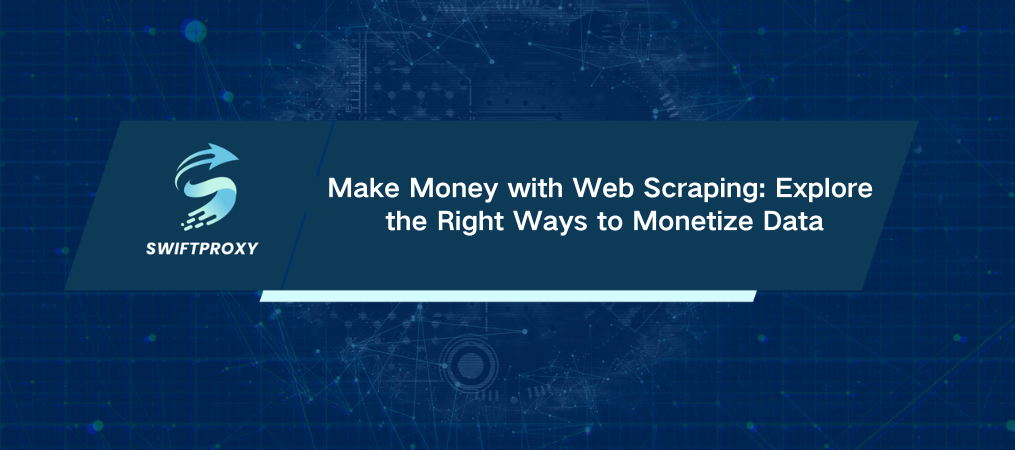Make Money with Web Scraping: Explore the Right Ways to Monetize Data

Data is everywhere. Every single day, 328.77 million terabytes are created, and 90% of the world's data has been generated in just the past two years. With this explosion of information, web scraping has become an essential tool. But how can it be profitable? Let's dive in.
Web scraping is the art of collecting data from websites—whether it's prices, product info, or competitor analysis. This process can give you insights to help your business, or you can turn the data into a valuable commodity to sell. But how does it all work? And how can you cash in on it?
What Is Web Scraping
Think of web scraping as data extraction. It's the act of pulling information from online sources for analysis, whether it's for tracking prices, spotting trends, or gathering competitive intel. Parsing, on the other hand, refers to the analysis of that data once you've got it.
To get started with scraping, here's a simple process:
· Find your target data: Know exactly what you want to extract—be it product prices, job listings, or news updates.
· Build or buy a bot: There are plenty of tools out there to automate the process.
· Extract the data: The bot collects the info from your target.
· Organize it: Structure the data into an easy-to-read format.
· Analyze or sell it: Use it for your business or sell it to others in need of it.
But be warned. Websites don't like being scraped. Many have anti-scraping measures to protect their data. Ethical scraping means staying within legal boundaries—avoiding personal or sensitive data and using the info in a way that doesn't harm the original site. And don't overwhelm websites with too many requests; this can crash their servers.
How to Turn Web Scraping into Profit
There are several ways to make money with web scraping. Let's explore the most lucrative:
1. Competitive Intelligence
Businesses use web scraping to keep an eye on their competitors. By tracking competitor prices and services, they can adjust their offerings to stay competitive. Real-time data helps them make smarter pricing decisions and boost their profits. For example, a retailer might scrape competitor pricing to offer better deals or track discounts for potential profit.
2. Build and Sell Bots
If you know how to build bots, you can create them to automate tasks like finding the best deals, sorting data, or monitoring brand mentions. These bots are in demand by businesses looking to streamline their operations. Selling these tools, especially ones that automate repetitive tasks, can be a steady income source.
3. Resell Discounted Goods
Imagine scraping online stores for discounts, buying items at a low price, and reselling them at a higher margin. Scrapers can track price drops, find the best offers, and even calculate discount percentages. After buying these discounted products, you can flip them for a profit—whether through e-commerce platforms or local sales.
4. Sell Data
Raw data is extremely valuable. AI companies, analysts, and marketers rely on structured datasets for everything from training machine learning models to analyzing trends. By scraping and cleaning data, you can sell it to businesses that need it. This is especially profitable if you can gather large sets of structured data like product prices, user reviews, or public records.
5. Monetize with Ads
Create a content-heavy site—using web scraping to pull in relevant content from around the web—and monetize it with ads. Sites that rank high on Google often attract ad revenue. For example, scraping Google search queries or related YouTube videos can fuel high-traffic pages that earn from display ads. This is a smart way to make money passively.
Each of these methods demonstrates how versatile web scraping can be. By turning data into a marketable commodity, you open yourself to a wide range of income streams in today's data-driven world.
What Tools Should You Use for Web Scraping
To get your scraping up and running, you'll need the right tools. These vary depending on your technical expertise, but here's a breakdown:
· Easy-to-use tools: Octoparse, DataOx, ScrapingBot. These tools come with built-in features and are ideal if you're not a coder. They're not free, but they simplify the process.
· Automation libraries: Beautiful Soup, Requests, lxml, Puppeteer. These are great for specific tasks, like parsing HTML or automating simple steps. Some coding experience is required.
· Full-featured frameworks: Scrapy, Selenium, Apify SDK. These provide robust scraping solutions and are more suited to large-scale projects.
· Custom scripting: If you're fluent in Python, Go, or PHP, you can write your own scripts. This gives you the most flexibility but requires solid coding skills.
No matter which tool you choose, you'll need proxies to ensure successful scraping. Here's why:
· Avoid Blocking: When you scrape websites, they can detect and block your IP address. Use rotating proxies to hide your real IP and mimic human behavior.
· Bypass Geolocation: Some websites restrict content based on location. Use proxies with specific geolocations to access content from anywhere.
· Stay Under the Radar: Sites also track digital fingerprints to identify and block scrapers. A multi-account browser like Octo can help mask your identity.
For serious scrapers, Octo Browser is a game-changer. It helps you manage proxies, bypass anti-scraping measures, and even avoid CAPTCHAs. Plus, it has a versatile API to automate your tasks.
Final Thoughts
Web scraping is a legitimate and profitable way to gather data. With the right tools, knowledge, and ethical practices, you can turn scraping into a revenue stream. Whether you're selling data, building bots, or flipping discounted products, the opportunities are vast.
Don't wait—start exploring the potential of web scraping. And remember, using the right browser and proxies will make all the difference.

















































